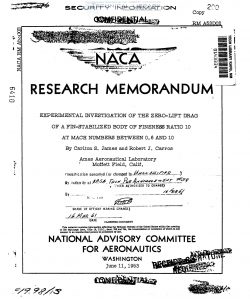naca-rm-a53d02
- Version
- 114 Downloads
- 1.44 MB File Size
- 1 File Count
- August 13, 2017 Create Date
- August 13, 2017 Last Updated
National Advisory Committee for Aeronautics, Research Memorandum - Experimental Investigation of the Zero lift Drag of a Fin Stabilized Body of Fineness Ratio 10 at Mach Numbers Between 0.6 and 10

Free-flight measurements were made of the zero-lift drag of a
cruciform-finned body at Mach numbers between 0.6 and 10. Reynolds
numbers varied between 0.9 million and 16 million. It was observed that
the drag coefficient after increasing sharply through Mach number 1 drops
rapidly in the low supersonic region to values well below the subcritical
value. The drag coefficients at Mach numbers above 5 were less than half
the M = 0.6 value, and the variation of drag coefficient with Mach number
was considerably less at Mach numbers above 5 than at Mach numbers
below 5.
The zero—lift drag of this model was predicted over the range of
Mach numbers from 1.5 to lO and compared with the experimental results.
At Mach number 5 a maximum disagreement between theory and experiment
of 18 percent occurred. Above and below this Mach number the agreement
improved so that over most of the Mach number range itwas'within53percent.
Accuracy of the prediction was affected principally by uncertainties in
the base drag estimate at lOW'MaCh numbers and in the location of
boundaryhlayer transition at all Mach numbers.
The effect of Reynolds number on the drag was measured at two Mach
numbers, h.7 and 7.2, and was found to be small. The ranges of Reynolds
numbers covered were between A million and 9 million at M = h.7 and
between 7 million and 16 million at M = 7.2.
An indication was Obtained from preliminary data that the effect
on total drag of varying the fin leading-edge profile is small if extreme
bluntness is avoided.
In the field of missile aerodynamics there is an increasing need
for experimental data at high supersonic Mach numbers for the purpose
of testing the validity of existing theory at these speeds as well as
for direct use in design calculations. At Mach numbers greater than
5 very little aerodynamic data have as yet been published with which
theoretical predictions can be compared.
One of the fundamental parameters is the drag, which often is
important in considerations of range, velocity, and missile size. It
was the twofold purpose of the investigation described in this report
to provide total drag data for a finned missile configuration over as
wide a range of Mach numbers as possible, and to determine the degree
of accuracy with which existing theoretical methods can be expected to
predict the drag of this and similar configurations throughout the super-
sonic speed range of the test.
| File | Action |
|---|---|
| naca-rm-a53d02 Experimental Investigation of the Zero lift Drag of a Fin Stabilized Body of Fineness Ratio 10 at Mach Numbers Between 0.6 and 10.pdf | Download |

Comment On This Post